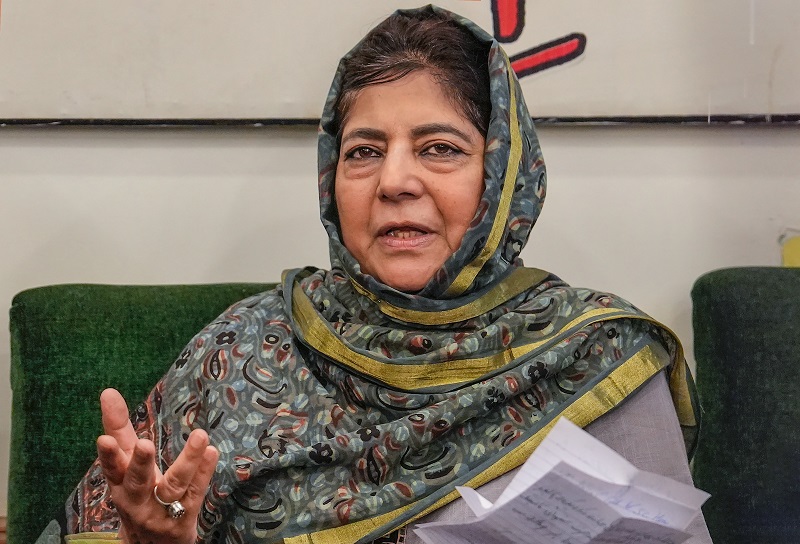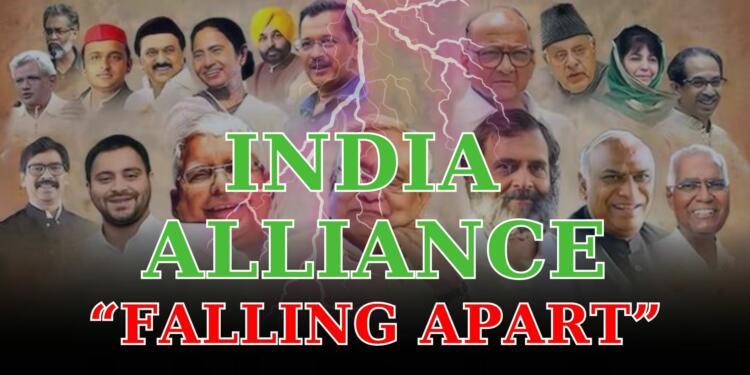The INDIA Alliance, initially hailed as a formidable coalition against the ruling Bharatiya Janata Party (BJP), emerged onto India’s political stage with grand aspirations of unifying diverse regional parties under a common banner. Its formation aimed to counter the BJP’s growing influence and perceived threats to India’s secular fabric and democratic values. Comprising influential parties like the Trinamool Congress, Samajwadi Party, and Rashtriya Janata Dal, the alliance sought to consolidate anti-BJP votes and present a viable alternative. However, internal conflicts, lack of consensus on crucial issues, and the failure to adapt to changing political landscapes led to its unraveling. The subsequent departure of key members like Nitish Kumar, criticism from leaders like Mamata Banerjee, and diverging electoral strategies further fractured the alliance, ultimately impacting the balance of power in Indian politics.
The Rise and Fall of the INDIA Alliance
The INDIA Alliance emerged onto India’s political stage with grand aspirations and a unified front against the ruling Bharatiya Janata Party (BJP). Initially, it was hailed as a formidable coalition, bringing together diverse regional parties under a common banner to challenge the BJP’s dominance. However, as time progressed, the alliance’s unity began to crumble, revealing underlying fissures and challenges that ultimately led to its unraveling.
Formation and Objectives
The INDIA Alliance was conceived as a response to the BJP’s growing influence and perceived threats to India’s secular fabric and democratic values. It aimed to unite various regional parties and factions across the country, transcending regional and ideological differences, to present a united front against the BJP in national elections. The primary objective was to consolidate anti-BJP votes and offer a viable alternative to the ruling party.
Key Members and Contributions
The alliance comprised influential regional parties such as the Trinamool Congress (TMC) led by Mamata Banerjee, the Samajwadi Party (SP) led by Akhilesh Yadav, and the Rashtriya Janata Dal (RJD) led by Tejashwi Yadav, among others. Each member brought its own electoral stronghold and grassroots support base to the alliance, contributing to its perceived strength and potential to challenge the BJP’s electoral hegemony.

Internal Conflicts and Power Struggles
Within member parties, internal conflicts and power struggles brewed, undermining the cohesion of the alliance. Egos clashed, and ambitions collided as leaders jockeyed for supremacy within the coalition. These internal rifts weakened the alliance’s unity and sowed seeds of discord.
Lack of Consensus on Crucial Issues
Despite shared opposition to the BJP, the alliance struggled to reach consensus on critical issues such as seat-sharing and leadership roles. Negotiations often faltered, leading to deadlock and frustration among member parties. The inability to resolve these disputes eroded trust and solidarity within the alliance.
Failure to Adapt to Changing Landscapes
As Indian politics evolved, the alliance failed to adapt to shifting dynamics and ground realities. Emerging challenges, such as the BJP’s aggressive campaigning strategies and changing voter preferences, caught the alliance off guard. Its inability to anticipate and respond effectively to these changes weakened its position.
Dynastic Legacies and Centralized Control
Certain member parties, notably the Congress, grappled with dynastic legacies and centralized control under prominent political families. This top-down leadership structure stifled internal democracy and marginalized dissenting voices within the alliance. As a result, regional leaders felt sidelined and disempowered, exacerbating tensions within the coalition.
Catalysts of Discontent
The unraveling of the INDIA Alliance can be attributed to a series of pivotal moments that exacerbated existing tensions and ultimately led to its downfall. Three key catalysts of discontent stand out Nitish Kumar’s departure, Mamata Banerjee’s criticism, and Mehbooba Mufti’s decision for the People’s Democratic Party (PDP) to contest elections independently.
Nitish Kumar’s Departure
Nitish Kumar’s exit from the alliance marked a significant blow to its unity and stability. As the enigmatic Chief Minister of Bihar, Kumar wielded considerable influence within the coalition.

His decision to part ways with the alliance stemmed from perceived disagreements over key issues, including leadership roles and strategic direction. Kumar’s departure exposed underlying fissures and power struggles within the alliance.
The repercussions of Kumar’s exit reverberated throughout the coalition, fueling uncertainty and further fracturing already strained relationships among member parties.
Mamata Banerjee’s Criticism and Distancing
Mamata Banerjee, the firebrand Chief Minister of West Bengal and a prominent member of the alliance, voiced vocal criticism against the Congress party’s leadership and its handling of alliance dynamics.
Banerjee’s scathing remarks underscored growing discontent and disillusionment among regional leaders towards the perceived dominance of the Congress and the Gandhi family within the coalition.
Her decision to distance herself from the alliance sent shockwaves through the opposition landscape, signaling deep-seated divisions and weakening the alliance’s collective resolve.
Also Read: PM Modi has successfully sent Mamata in a state of shock and despair
Mehbooba Mufti’s Independent Electoral Strategy

Mehbooba Mufti’s announcement that the PDP would contest elections independently further strained the fragile unity of the alliance. The decision highlighted growing disillusionment and diverging priorities among member parties.
Mufti’s move reflected broader frustrations within the PDP over the alliance’s inability to address the unique challenges facing the region of Jammu and Kashmir. It underscored the alliance’s failure to accommodate the diverse interests and aspirations of its members.
The PDP’s decision to chart its own electoral course signaled a loss of faith in the alliance’s ability to effectively represent and address the concerns of regional constituents.
Congress – A Central Figure in the Alliance’s Demise
The Congress party and the Gandhi family played a central role in the demise of the INDIA Alliance, contributing significantly to its disintegration through delayed tactics, internal factions, power struggles, and a failure to provide cohesive leadership and articulate a compelling vision.
Role of the Gandhi Family
The Congress, as one of the oldest and largest political parties in India, held a pivotal position within the INDIA Alliance. With its historical significance and nationwide presence, the Congress was expected to provide leadership and cohesion to the coalition.
However, the centralized control exerted by the Gandhi family, particularly Rahul Gandhi and Sonia Gandhi, became a point of contention within the alliance. Their dominance over decision-making processes and reluctance to empower regional leaders led to resentment and discord among coalition partners.
The Gandhi family’s leadership style, characterized by a top-down approach and a focus on dynasty politics, hindered the alliance’s ability to function cohesively. Instead of fostering unity and collaboration, their control exacerbated internal factions and power struggles within the Congress and the broader coalition.
Analysis of Delayed Tactics, Internal Factions, and Power Struggles
The Congress’s delayed tactics and indecisiveness further undermined the alliance’s effectiveness. Crucial decisions, such as seat-sharing agreements and leadership roles, were often postponed or mishandled, leading to frustration and mistrust among coalition partners.
Internal factions within the Congress, fueled by competing interests and ambitions, exacerbated divisions within the alliance. Factionalism, particularly between supporters of the Gandhi family and other prominent leaders, weakened the party’s cohesion and undermined its ability to project a united front.
Power struggles within the Congress, both at the national and state levels, further complicated matters within the alliance. Infighting over leadership positions and strategic direction diverted attention away from the alliance’s objectives, eroding its strength and credibility.
Failure to Provide Cohesive Leadership
Despite its historical legacy and organizational infrastructure, the Congress failed to provide cohesive leadership and articulate a compelling vision for the alliance. Infighting, indecision, and a lack of strategic direction hampered the party’s ability to effectively lead the coalition.
The Congress’s failure to present a clear alternative to the ruling BJP’s agenda and policies weakened the alliance’s appeal to voters. A lack of coherent messaging and vision further eroded public confidence in the coalition’s ability to govern effectively.
Impact on Indian Politics
The disintegration of the INDIA Alliance has profound ramifications for Indian politics, with far-reaching consequences that impact the balance of power, the effectiveness of opposition movements, and the trajectory of democratic governance. The primary consequences include
Strengthening the BJP’s Position and Dominance
With the opposition alliance crumbling, the ruling Bharatiya Janata Party (BJP) stands to benefit significantly. The absence of a united opposition reduces the electoral challenge posed by the BJP, allowing it to consolidate power and pursue its political agenda more aggressively.
The BJP, under the leadership of Prime Minister Narendra Modi, has capitalized on the weaknesses and divisions within the opposition to strengthen its position at both the national and state levels. The disintegration of the INDIA Alliance further solidifies the BJP’s dominance in Indian politics.
Fragmentation of Opposition Forces
The collapse of the alliance results in the fragmentation of opposition forces, making it difficult to mount an effective challenge against the BJP. Without a cohesive and united front, opposition parties are unable to leverage their collective strength and resources to counter the ruling party’s electoral machinery.
The absence of a strong opposition alliance allows the BJP to exploit divisions and exploit electoral vulnerabilities in various states. Regional parties, lacking a national platform for coordination, may prioritize their local interests over broader opposition goals, further fracturing the anti-BJP coalition.
Loss of Momentum and Direction in Opposition Movements
The disintegration of the INDIA Alliance deals a significant blow to opposition movements, leading to a loss of momentum and direction. The lack of a coherent opposition narrative and strategy undermines efforts to hold the government accountable and advocate for alternative policies.
Opposition parties may struggle to rally public support and mobilize voters in the absence of a united front. Without a clear vision and leadership, opposition movements risk becoming fragmented and ineffective, allowing the BJP to maintain its political hegemony.
The demise of the INDIA Alliance marks a significant turning point in Indian politics, with far-reaching consequences for opposition movements and the country’s democratic governance. The collapse of this once-promising coalition has strengthened the position of the ruling Bharatiya Janata Party (BJP) and fragmented opposition forces, making it challenging to mount an effective challenge.






























